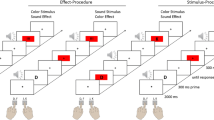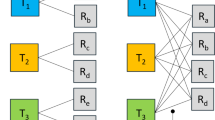Abstract
Responding to stimuli leads to the formation of stimulus–response (S–R) associations that allow stimuli to subsequently automatically trigger associated responses. A recent study has shown that S–R associations are established not only by active task execution, but also by the simultaneous presentation of stimuli and verbal codes denoting responses in the absence of own action [Pfeuffer et al. (Journal of Experimental Psychology: Human Perception and Performance 43:328–347, 2017)]. Here, we used an item-specific priming paradigm to investigate whether the stimulus part of S–R associations formed based on task execution and verbal codes is represented in abstract or specific format by examining whether S–R associations are retrieved for perceptually different forms of the same stimulus or not. Between the prime and probe instance of a stimulus, its format switched from image to word or vice versa. We found that, irrespective of whether stimuli were primed by task execution or verbal coding, performance was impaired when S–R mappings switched rather than repeated between the prime and probe instance of a stimulus. The finding that prime S–R mappings affected probe performance even when stimulus format switched indicates that stimuli were represented in abstract form in S–R association based on both task execution and verbal coding. Furthermore, we found no performance benefits for stimuli primed and probed in the same format rather than different formats, suggesting that stimuli were not additionally represented in specific format. Overall, our findings demonstrate the adaptability of automatized behaviors and indicate that abstract stimulus representations allow S–R associations to generalize across perceptually different stimulus formats.




Similar content being viewed by others
Notes
Please note that the percentage of excluded probe trials is not the summation of the previously mentioned percentages of excluded trials, as several exclusion criteria can apply to one probe trial. For instance, participants could have responded incorrectly during both prime and corresponding probe. Probe trials with erroneous responses or response omissions during primes are commonly excluded in item-specific priming studies, as it cannot be determined which associations participants might have formed during such prime trials.
Please note that the stimulus sets in the experiments differed partly. Additionally, mean probe RTs (and PEs) differed between the three experiments. For both stimuli probed in word and image format, RTs in Experiment 1, in which stimulus format changed between prime and probe, were larger than in Experiment 2 and the study of Pfeuffer et al. (2017), respectively. As some priming effects increase in size with increasing RTs, differences in the size of S–A and S–C switch costs between stimuli probed in the same vs. a different format might thus have been overshadowed by the overall difference in RTs.
References
Allenmark, F., Moutsopoulou, K., & Waszak, F. (2015). A new look on S–R associations: How S and R link. Acta Psychologica, 160, 161–169.
Brady, T. F., Konkle, T., Alvarez, G. A., & Oliva, A. (2008). Visual long-term memory has a massive storage capacity for object details. Proceedings of the National Academy of Sciences of the United States of America, 105, 14325–14329.
Denkinger, B., & Koutstaal, W. (2009). Perceive-decide-act, perceive-decide-act: How abstract is repetition-related decision learning? Journal of Experimental Psychology: Learning, Memory, and Cognition, 35, 742–756.
Dennis, I., & Schmidt, K. (2003). Associative processes in repetition priming. Journal of Experimental Psychology: Learning, Memory, and Cognition, 29, 532–538.
Dobbins, I. G., Schnyer, D. M., Verfaellie, M., & Schacter, D. L. (2004). Cortical activity reductions during repetition priming can result from rapid response learning. Nature, 428, 316–319.
Henson, R. N., Eckstein, D., Waszak, F., Frings, C., & Horner, A. J. (2014). Stimulus–response bindings in priming. Trends in Cognitive Sciences, 18, 376–384.
Hommel, B. (1998). Event files: Evidence for automatic integration of stimulus–response episodes. Visual Cognition, 5, 183–216.
Horner, A. J., & Henson, R. N. (2009). Bindings between stimuli and multiple response codes dominate long-lag repetition priming in speeded classification tasks. Journal of Experimental Psychology. Learning, Memory, and Cognition, 35, 757–779.
Horner, A. J., & Henson, R. N. (2011). Stimulus–response bindings code both abstract and specific representations of stimuli: Evidence from a classification priming design that reverses multiple levels of response representation. Memory and Cognition, 39, 1457–1471.
Horner, A. J., & Henson, R. N. (2012). Incongruent abstract stimulus–response bindings result in response interference: fMRI and EEG evidence from visual object classification priming. Journal of Cognitive Neuroscience, 24, 760–773.
Hsu, Y. F., & Waszak, F. (2012). Stimulus–classification traces are dominant in response learning. International Journal of Psychophysiology, 86, 262–268.
Logan, G. D. (1988). Toward an instance theory of automatization. Psychological Review, 95, 492–527.
Logan, G. D. (1990). Repetition priming and automaticity: Common underlying mechanisms? Cognitive Psychology, 22, 1–35.
Moutsopoulou, K., Yang, Q., Desantis, A., & Waszak, F. (2015). Stimulus–classification and stimulus–action associations: Effects of repetition learning and resilience. Quarterly Journal of Experimental Psychology, 68, 1744–1757.
Pfeuffer, C. U., Moutsopoulou, K., Pfister, R., Waszak, F., & Kiesel, A. (2017). The power of words: On item-specific stimulus–response associations formed in the absence of action. Journal of Experimental Psychology: Human Perception and Performance, 43, 328–347.
Schnyer, D. M., Dobbins, I. G., Nicholls, L., Davis, S., Verfaellie, M., & Schacter, D. L. (2007). Item to decision mapping in rapid response learning. Memory and Cognition, 35, 1472–1482.
Waszak, F. (2010). Across-task long-term priming: Interaction of task readiness and automatic retrieval. The Quarterly Journal of Experimental Psychology, 63, 1414–1429.
Waszak, F., Hommel, B., & Allport, A. (2003). Task-switching and long-term priming: Role of episodic stimulus–task bindings in task-shift costs. Cognitive Psychology, 46, 361–413.
Author information
Authors and Affiliations
Corresponding author
Ethics declarations
Funding
This research was supported by a grant of the Deutsche Forschungsgemeinschaft (KI1388/5-1, Andrea Kiesel) and a grant of the Agence Nationale de la Recherche (SRA ANR-13-FRAL-0007-01, Karolina Moutsopoulou).
Conflict of interest
The authors declare that they have no conflict of interest.
Ethical standards
All procedures performed in studies involving human participants were in accordance with the ethical standards of the institutional and/or national research committee and with the 1964 Helsinki declaration and its later amendments or comparable ethical standards.
Informed consent
Informed consent was obtained from all individual participants included in the study.
Additional information
The data of the reported experiments as well as experiment files and syntaxes are available via the Open Science Framework: https://osf.io/wusym/; doi:10.17605/OSF.IO/WUSYM.
Appendix
Appendix
Experiment 1
Prime RT and PE analyses
We used a 2 × 2 × 2 repeated measures ANOVA with the within-subject factors prime–probe format, classification, and action to investigate possible a priori differences between conditions in executed blocks. Trials in verbally coded blocks were not analyzed as they did not contain any performance measures. Both the analysis of prime RTs and the analysis of prime PEs revealed a significant difference in performance between object images and object names, RTs: F(1,38) = 64.05, p < 0.001, η p 2 = 0.63, PEs: F(1,38) = 8.25, p = 0.007, η p 2 = 0.18. Object images were classified faster and more accurately than object names. All other RT, Fs ≤1.60, ps ≥0.214, η p 2 ≤ 0.04, and PE effects, Fs ≤ 1.73, ps ≥ 0.197, η p 2 ≤ 0.04, failed to reach significance.
Memory recall analyses
Participants recalled 49.8% of prime actions (50.2% executed, 49.5% verbally coded) and 62.1% of prime classifications (62.3% executed, 61.8% verbally coded). One-sample t test showed that participants recall performance for actions did not significantly differ from chance (50%) for any combination of prime type and prime–probe format, t(38) ≥−1.09, ps ≥0.282, ds ≤0.17. Performance on classification recall trials was significantly above chance (50%) for all combinations of prime type and prime–probe format, t(38) ≥ 3.54, ps ≤0.001, ds ≥0.57.
A 2 × 2 × 2 repeated measures ANOVA with the within-subject factors memory type (action vs. classification), prime type (executed vs. verbally coded), and prime stimulus type (image vs. word) showed that recall performance was significantly better for classifications than for actions, F(1,38) = 44.60, p < 0.001, η p 2 = 0.54. Furthermore, participants were significantly better at recalling the classifications for stimuli primed as pictures in comparison to stimuli primed as words, F(1,38) = 8.45, p = 0.006, η p 2 = 0.18. Finally, memory type and prime stimulus type significantly interacted, F(1,38) = 16.83, p < 0.001, η p 2 = 0.31. Both for stimuli primed as pictures, t(38) = 8.00, p < 0.001, d = 1.28, and for stimuli primed as words, t(38) = 3.89, p < 0.001, d = 0.62, participants were significantly better at recalling classifications in comparison to actions. The effect of memory type was, however, more pronounced for stimuli primed as pictures. All other effects failed to reach significance, Fs ≤2.98, ps ≥0.092, η p 2 ≤ 0.07.
Discussion
The prime analyses revealed that RTs and PEs were higher when participants classified object names rather than object images. Apart from performance differences between prime–probe formats, no a priori differences between conditions were observed. Replicating the findings of Pfeuffer et al. (2017), we found that memory recall performance was better for classifications than for actions. Participants’ recall performance for classifications was above chance level, whereas their action recall performance did not differ from chance. Interestingly, recall performance was overall better for stimuli primed as pictures in comparison to stimuli primed as words and the recall performance differences between action and classification were more pronounced for stimuli primed as pictures.
Experiment 2
Prime RT and PE analyses
To explore possible a priori differences between conditions, 2 × 2 repeated measures ANOVAs with the factors classification and action were conducted on prime RTs and PEs. Neither the RT analysis, Fs ≤1.74, ps ≥0.195, η p 2 ≤ 0.04, nor the PE analysis, Fs <1, revealed any significant differences.
Memory recall analyses
Participant recalled 56.0% of actions in executed blocks and 66.0% of actions in verbally coded blocks. In executed blocks, they recalled 64.3% of classifications and in verbally coded blocks they recalled 66.8%. One-sample t test showed that participants’ recall performance was significantly above chance level (50%) for both action and classification recall and both prime types, t(39) ≥3.12, ps ≤0.001, ds ≥0.67.
A 2 × 2 repeated measures ANOVA with the factors memory type (classification vs. action) and prime type (executed vs. verbally coded) showed that participants recalled classifications more accurately than actions, F(1,39) = 12.28, p = 0.001, η p 2 = 0.24. Furthermore, recall performance was significantly better in verbally coded blocks as compared to executed blocks, F(1,39) = 10.37, p = 0.003, η p 2 = 0.21. Memory type (classification vs. action) and prime type significantly interacted, F(1,39) = 8.88, p = 0.005, η p 2 = 0.19. Recall performance was significantly better for classifications in comparison to actions in executed blocks, t(39) = 4.53, p < 0.001, d = 0.72, but not in verbally coded blocks, t(39) = 0.42, p = 0.680, d = 0.07.
Discussion
We did not observe any a priori differences between conditions during prime trials that could have accounted for our probe trial results. Moreover, in line with previous findings (Pfeuffer et al., 2017) recall performance was above chance for both action and classification recall, with classification recall performance being better than action recall performance. However, contrary to the findings of Pfeuffer et al. (2017), classification recall performance only exceeded action recall performance in executed blocks, but not in verbally coded blocks.
Rights and permissions
About this article
Cite this article
Pfeuffer, C.U., Hosp, T., Kimmig, E. et al. Defining stimulus representation in stimulus–response associations formed on the basis of task execution and verbal codes. Psychological Research 82, 744–758 (2018). https://doi.org/10.1007/s00426-017-0861-y
Received:
Accepted:
Published:
Issue Date:
DOI: https://doi.org/10.1007/s00426-017-0861-y




